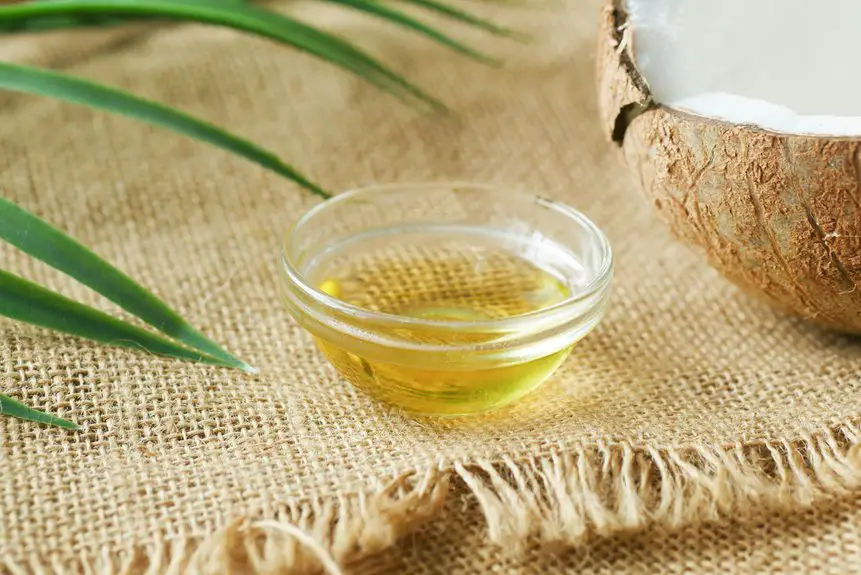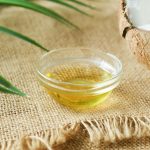If you get coconut oil on fabric, start by blotting the excess gently with a clean cloth—don’t rub it in. Sprinkle baking soda, cornstarch, or baby powder over the stain to absorb the oil, then brush off after 30 minutes. You can also apply a little dish soap or white vinegar directly, blotting carefully. For stubborn spots, use a hairdryer on low heat to loosen the oil before blotting again. Keep going and you’ll find more effective ways to restore your fabric.
Table of Contents
Key Takeaways
- Blot excess coconut oil gently with a clean cloth or paper towel without rubbing to avoid spreading the stain.
- Sprinkle baking soda, cornstarch, or baby powder on the stain and let it absorb oil for 30 minutes before brushing off.
- Apply a small amount of fabric-safe dish soap on the stain and rub gently in circular motions to break down the oil.
- Use a hairdryer on low or medium heat to warm the oil, then blot with a clean cloth to lift the softened stain.
- Allow the fabric to air dry completely and repeat the absorption and blotting process if any oil remains.
Blotting Excess Coconut Oil Immediately
As soon as you notice coconut oil on your fabric, blot the excess gently with a clean cloth or paper towel to prevent it from soaking deeper into the fibers.
Don’t rub or scrub, as that will only spread the oil and embed it further. Instead, press down lightly and lift the cloth repeatedly, absorbing as much oil as possible.
Use fresh sections of the cloth or fresh paper towels as the oil transfers, so you’re not reapplying it. Acting quickly here is key because coconut oil can stain fabric if left untreated.
Using Baking Soda to Absorb Oil
Three simple steps can help you use baking soda to effectively absorb coconut oil from fabric. First, sprinkle a generous layer of baking soda directly onto the oily spot. Next, let it sit for 30 minutes to an hour to soak up the oil. Finally, gently brush off the powder with a soft cloth or brush.
| Step | Action | Result |
|---|---|---|
| 1. Sprinkle | Apply baking soda on stain | Baking soda covers the oil |
| 2. Wait | Let it sit for 30-60 minutes | Oil absorbs into powder |
| 3. Brush off | Remove baking soda gently | Oil lifts off fabric |
This method prevents the oil from setting into the fabric fibers, making further removal easier.
Applying Cornstarch for Stain Removal
Although coconut oil can be stubborn, you can effectively lift stains by applying cornstarch directly onto the affected fabric.
Sprinkle a generous layer over the oil spot, guaranteeing full coverage. Let it sit for at least 30 minutes so the cornstarch can absorb the oil thoroughly. For tougher stains, leaving it on for a few hours or overnight works even better.
Afterward, gently brush off the powder using a soft brush or cloth. You should notice the stain lightening considerably. If needed, repeat the process until the fabric looks cleaner.
Cornstarch’s absorbent properties make it a great natural option to tackle coconut oil without washing immediately. Just remember to test on a hidden area first to verify it won’t affect your fabric’s color or texture.
Utilizing Baby Powder to Lift Oil Stains
You can use baby powder to absorb coconut oil stains effectively.
Just sprinkle a generous layer over the affected area and let it sit for at least 30 minutes.
Afterward, gently brush off the powder to remove the oil residue from your fabric.
Applying Baby Powder
To lift coconut oil stains from fabric, sprinkle baby powder directly onto the affected area and let it soak up the oil. The powder absorbs the grease, making it easier to remove without washing. After about 30 minutes, gently brush off the powder with a soft brush or cloth. Repeat if necessary for stubborn stains. This method works best on fresh stains and delicate fabrics.
| Step | Tips |
|---|---|
| Sprinkle powder | Use a generous layer |
| Wait | Allow 20-30 minutes |
| Brush off | Use a soft, dry brush |
| Repeat if needed | Reapply for deep stains |
Applying baby powder is a simple, effective way to tackle oil stains quickly.
Removing Oil Residue
Three simple steps can help you effectively remove oil residue from fabric using baby powder.
First, sprinkle a generous amount of baby powder directly onto the stained area. The powder will absorb the excess oil, making it easier to lift.
Next, let the powder sit on the fabric for at least 30 minutes; for tougher stains, you can leave it overnight.
Finally, gently brush off the powder with a soft brush or cloth, and you’ll notice the oil residue diminishing.
If necessary, repeat the process until the stain fades completely.
This method works well without washing, allowing you to freshen up your fabric quickly and efficiently without water or detergent.
It’s a simple, effective way to handle coconut oil stains on the spot.
Rubbing Dish Soap on the Affected Area
You’ll want to pick a dish soap that’s strong enough to cut through the oil but gentle on your fabric.
Apply it directly to the stain and gently rub it in to break up the coconut oil.
Afterward, make sure to rinse thoroughly to remove all soap residue and prevent any new marks.
Choosing the Right Soap
Selecting the right soap makes a big difference when tackling coconut oil stains. You want a dish soap that’s strong on grease but gentle on fabric.
Look for soaps labeled “degreaser” or “grease-cutting” as they break down oil effectively. Avoid soaps with added moisturizers or heavy fragrances—they can leave residue or worsen the stain. Clear, colorless soaps tend to be less likely to dye the fabric.
If you’re unsure, test a small drop on an inconspicuous area first. Brands like Dawn or Palmolive are popular because they combine powerful grease removal with fabric safety.
Application Techniques
Once you’ve picked the right dish soap, it’s time to apply it directly to the coconut oil stain. First, squeeze a small amount onto the affected area. Then, gently rub the soap into the fabric using your fingers or a soft cloth. Work in circular motions to break down the oil without damaging the fabric.
Here’s a quick guide:
| Step | Action | Tips |
|---|---|---|
| 1 | Apply soap | Use a drop, not a puddle |
| 2 | Rub gently | Circular motions, light pressure |
| 3 | Let sit briefly | 5-10 minutes before next step |
This technique helps loosen the oil so it can be lifted off more easily.
Removing Soap Residue
After scrubbing the dish soap into the stain, it’s crucial to remove any soap residue thoroughly.
You’ll want to dampen a clean cloth with warm water and gently blot the area to lift the soap away. Avoid rubbing too hard, as that can push the residue deeper into the fabric. Keep blotting with a fresh, damp cloth until the soap no longer appears or feels slippery.
Once you’ve removed the soap, pat the fabric dry with a dry towel to absorb excess moisture. This step helps prevent any leftover soap from attracting dirt or causing stiffness.
Removing soap residue properly guarantees your fabric feels fresh and clean without needing a full wash, keeping your garment looking its best.
Employing White Vinegar as a Spot Cleaner
Although coconut oil can be stubborn on fabric, you can effectively tackle the stain by using white vinegar as a spot cleaner.
White vinegar breaks down oil molecules, making it easier to lift the stain without a full wash. Here’s how to do it:
- Dab a small amount of white vinegar on a clean cloth.
- Gently blot the stained area without rubbing to avoid spreading.
- Let the vinegar sit on the stain for 5–10 minutes.
- Use a dry cloth to absorb the loosened oil.
- Repeat if necessary until the stain fades.
This method works well for fresh or slightly set-in stains and preserves fabric integrity.
Just test vinegar on a hidden spot first to verify it won’t discolor your fabric.
Treating the Stain With Rubbing Alcohol
If white vinegar doesn’t fully remove the coconut oil stain, you can turn to rubbing alcohol to break down the grease further.
Dampen a clean cloth or cotton ball with rubbing alcohol and gently dab the stained area. Avoid rubbing, as this can spread the oil or push it deeper into the fabric.
Let the alcohol sit for a few minutes to dissolve the oil. Then, blot the stain with a dry cloth to lift the loosened grease.
Repeat this process if necessary, but be cautious with delicate fabrics, as rubbing alcohol can sometimes cause discoloration. Always test a small, hidden area first to verify it won’t damage the fabric.
This method effectively targets oil without needing to wash immediately.
Using a Hairdryer to Loosen the Oil Stain
When rubbing alcohol doesn’t fully break down the coconut oil, applying gentle heat can help loosen the stain. Using a hairdryer lets you warm the fabric just enough to soften the oil, making it easier to blot away without spreading it.
Hold the hairdryer a few inches from the fabric and move it around to avoid overheating any spot. Once the oil feels warm and pliable, gently blot with a clean cloth or paper towel to lift the residue.
Keep these tips in mind when using a hairdryer on oil stains:
- Use a low or medium heat setting to prevent fabric damage
- Keep the hairdryer moving to avoid burning the material
- Blot, don’t rub, to avoid spreading the stain
- Test heat on a hidden area first
- Repeat heating and blotting if necessary for stubborn stains
Frequently Asked Questions
Can Coconut Oil Permanently Damage Fabric Fibers?
You won’t usually face permanent damage from coconut oil on fabric fibers, but if left untreated, it might cause stubborn stains or weaken fibers over time. Acting quickly helps protect your fabric’s quality and appearance.
Is It Safe to Use These Methods on Delicate Fabrics?
Imagine gently whispering to delicate petals; you’ll want to treat fragile fabrics with equal care. You shouldn’t use harsh methods on them—stick to mild, gentle techniques to avoid any unwanted “adventures” or fabric distress.
Will These Treatments Affect Fabric Color or Patterns?
You might notice slight fading or color changes if you use harsh treatments. Always test on a hidden area first to make sure your fabric’s colors and patterns stay intact before applying any stain removal method.
How Long Should I Wait Before Attempting Stain Removal?
You should act quickly to remove the stain, but if you can’t, wait until the oil cools and solidifies. This usually takes about 10 to 15 minutes, making it easier to lift without spreading the stain further.
Are These Methods Effective on Dried Coconut Oil Stains?
You’ll find these methods pretty effective on dried coconut oil stains, but you might need to repeat the process a few times. Dried oil is tougher, so patience and persistence really pay off here.
- Is Lyocell a Good Material for Underwear? We Investigate - July 14, 2025
- Is Lyocell Good for Sensitive Skin? A Dermatological Perspective - July 14, 2025
- Is Lyocell Stretchy? Understanding the Fabric’s Elasticity (Elastisch Explained) - July 14, 2025







